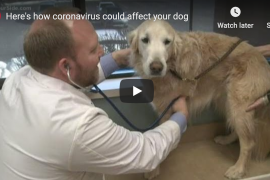Seeing your pet in pain is scary. Especially if you don’t know what’s wrong or what to do for them. This can include wondering if your dog is having a seizure.
A seizure is electrical activity happening in your dog’s brain and can happen for many reasons.
It can be a minor or thing such as small twitch or as serious as a grand mal seizure where your pet loses consciousness.
How do you know if your dog is having a seizure?
Signs of a Seizure
Sudden jerky movements can indicate a seizure.
If your dog begins jerking or twitchy while he’s sleeping try to gently wake him. If he wakes up it was merely a nightmare. If you cannot wake him it may be a seizure.
Other possible signs:
- Pupils will dilate
- Not recognize owner
- Turn vicious
- Looks like he’s paddling
- Lose control of his bodily functions and will defecate or urinate.
- Foams at the mouth
- Loses consciousness
- A partial seizure may happen in only one part of the body.
- Another type of seizure is when your dog runs around in circles or tries to hide from you. Watch closely because this can eventually lead to other seizures.
Three Stages of Seizures
Many seizures will happen in this order.
- Dog appears nervous and restless. May whine or shake.
- The Ictal stage is when the dog is actually having the seizure. He’ll often fall to his side and shake. Some dogs will seem paralyzed. This can last a few seconds or several minutes. If longer than five minutes your dog is having a prolonged seizure and may be epileptic.
- Next is the Post-ictal stage where you dog may appear dazed or confused. He may have problems with his vision.
Not all seizures will follow these stages, though, dependent on the actual cause.
What to Do
Protect yourself first by keeping yourself away from his mouth. He’s not in control and if he clamps down on your hand he won’t be able to let go. Don’t worry that he’s going to swallow his tongue or other things you might have heard.
Stay away from his paws, as well.
Move him carefully away from any furniture he might be under or near.
Try to calm your dog as much as possible.
Turn down the lights, speak softly and pet your dog gently.
Notice as much as you can about your dog’s condition, including how long the seizure lasts. After the seizure is over write down every thing you can remember so you can give the information to your dog’s vet.
If your dog losses consciousness take him to the vet immediately or if he has several seizures in one day.
Causes of Seizures
Seizures are not a disease. They are a symptom of another problem. There are several reasons your dog might experience a seizure.
- Bad reaction to different types of food
- Medications
- Extreme temperatures such as a heat stroke
- Poison
- Head injury
- Stressful situations such as contact with another animal or loud fireworks
- Epilepsy or other serious health conditions.
If you suspect your dog has had a seizure you should take him to the vet for a check-up. The vet can run tests to try and find out the cause of the seizure. If your dog has epilepsy he can be put on medication to help with the condition. Early intervention is the best course of action for any serious illness in your pet.



